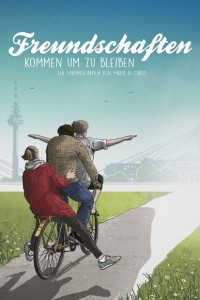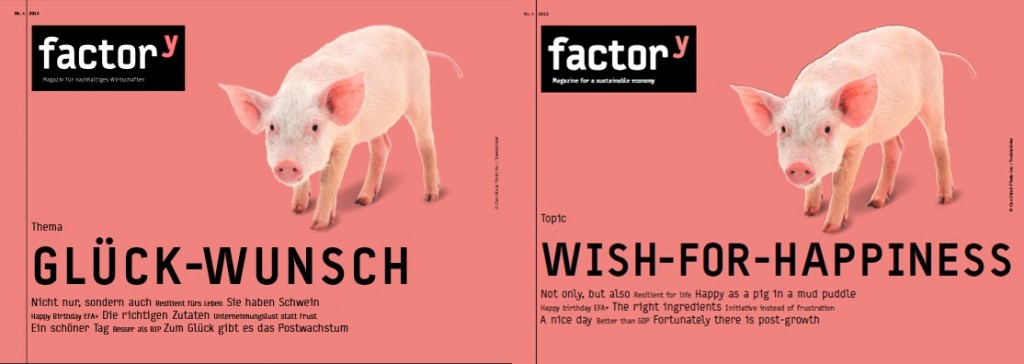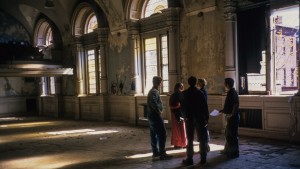Content
On this page, you can read about a few interesting projects done in classes facilitated by Don Kiraly at the FTSK. These projects are exemplary for the many past projects done over the past decade. Translation projects like the ones mentioned below are special because they extended over the better part of a semester and required students to invest many hours of work. Every project represents an exciting individual challenge for the students. They are all designed to help students develop autonomy as lifelong learners, a professional mindset and, in doing so, improve their language mediation skills.
FactorY
Translation of an Online Magazine for Economic Sustainability from German into English
What is FactorY?
FactorY is a German online journal on various aspects of economic sustainability that is published on a quarterly basis. Don Kiraly’s classes for translation from German into English in the field of economics translate new articles from FactorY each semester. It started out as a yearlong project which has since been carried on.
Who is involved in the project?
In the first semester, 37 students enrolled in the MA Translation Studies program and translated two issues of about 100 pages for the FactorY website. All of the students had English as their second language and all but one had completed a BA degree in the field of translation. All students had received considerable instruction in basic translation skills and a great deal of practice with the simulated translation of general and specialised texts into English.
For most of the students, the translations for FactorY constituted the first authentic translation project. The fact that the students’ names are listed as the official translators of the published texts served as an important motivation for the authentic project.
What was the objective of the project?
The objective of the project was to imitate an everyday situation for translators. Students should focus on the development of workplace competence, i.e. the effective completion of translation and editing tasks in teams. Students were expected to meet deadlines while still devoting the necessary time and effort to resolving translation and text-production problems according to professional standards. Strengthening the ability to work autonomously as well as in interdependent teams, was an essential aim of the project. The interdependence of the teams highlighted the responsibility for the individual team member in contrast to a mere groups of individuals. Students were expected to assume responsibility for their individual authentic tasks.
How was the project organised?
The course translated two issues of the journal (about 100 pages) within one semester. The first translation was completed in the first seven weeks of the semester, the second translation in the second half of the semester.
The course had three 90-minute meetings during each semester. In the first meeting, the group was introduced to the project and agreed on deadlines and procedures. In the second session in the middle of the semester, the first translation project was finalized, students discussed their work experience with Moodle, the online platform used for the project, and initiated the second project for the semester. The last meeting took place at the end of the semester, when the second translation project was completed and the experience with Moodle throughout the semester was discussed.
Each student had to prepare a rough draft of a segment of the text and upload it to Moodle where another student had to edit their partner’s text. The translator was then expected to make revisions on the translation on the basis of the editor’s comments. The revised texts were then uploaded to Moodle again where another student proofread the revised version. Lastly, the translator could make final changes to the text on the basis of the proofreader’s comments. The final text was then uploaded to Moodle and Don Kiraly, as the only English native speaker, did the final proofreading and submitted the completed translation to the client.
Results
The assessment of some of the passages led to great improvement from the initial drafts to the final version. The average quality of the final version of the texts was exceptionally good, especially if we bear in mind that the translations were produced by non-native speakers of English.
You can read the journal here. The articles can be found here.
Der Schrei
Subtitling a Documentary
One of Don Kiraly’s translation practice classes subtitled the 90-minute documentary film "Der Schrei der Vergessenen - Anna und die Irrenanstalt" about a young woman who discovers an abandoned asylum in the US and plans to turn it into an art project.
Who was involved in the project?
The project was undertaken by one of Don’s German-English translation practice classes consisting of only non-native English speakers.
Because Don had no experience of subtitling himself, he called in a former student who was experienced in multi-media translation.
During the semester another student served as a tutor, while the instructor set a basic framework for the class including a tentative plan for the project. Don found out that a recent graduate of the faculty was working locally as a professional subtitler. Upon his request, she agreed to critique the class's work.
How was the project organised?
At the beginning of the semester, the tutor gave a brief interactive introduction to the field of subtitling and demonstrated the basic functions of a freeware subtitling programme.
The translation work was carried out by the students individually or in small groups. First, a part of the film was divided into sections, students then worked in pairs at home and produced initial drafts. In class, students checked each other’s work. Don was available as a native speaker of English to help resolve translation problems. There were two plenary sessions to review all subtitles as a group. Finally, the class consensus decided on the final subtitles.
When the students started creating their own subtitles, the main constraints came from the client who decided that no subtitle line should have a total length of more than 34 characters. After finishing the subtitling work, the length was reduced to 26 characters per line which resulted in the students having to revise all subtitles and adjust those that were too long for the new convention. Apart from this and font and type size, there were no other specific information on the subtitling procedure, the whole process was entirely left to the students’ responsibility, which is very similar to the situation on the market, where clients often delegate full responsibility to the language mediation professional. The space and time constraints meant that the translation had to be short and concise and the speaker’s gist sometimes had to be simplified.
After the first six weeks of the course, the professional subtitler spent 90 minutes with the class, critiquing their work and also telling them about her work as a professional subtitler. She explained technical problems to the group like the occasional lack of synchronicity in the subtitles, which allowed the students to see problems from the viewer’s perspective that had been invisible to them before. Bearing in mind the subtitler’s comments, the students could now revise the subtitles and move on to the next section of the film being able to incorporate that new knowledge into their practice.
When the project was nearly finished, the company informed the group that they were unable to import the subtitles created in the freeware programme into their own video editing programme. Therefore one third of the students went to the company and worked in pairs to enter the subtitles by hand into the company’s video editing system. The client instructed each pair in the use of his hardware and software. Without their teacher’s guidance, the students finished the work within six working days. The client was astounded by the students’ level of competence as translators and subtitlers as well as their professional sense of responsibility. It turned out that the client did not know much about his own software, so the students ended up explaining not only the principles of subtitling, but also how to use the video editing software to the client.
Results
Don describes that “[...] the learning experience was approached as a collaborative situated enaction process with knowledge and skills expected to develop throughout the environment.” Instead of only receiving knowledge from others, students were involved in a much more authentic process of collaborative learning and real text production in close collaboration with a client. The teacher helped create a learning environment, brought in relevant human resources and served as a linguistic aide, but gradually withdrew his scaffolding, became a learner himself and let the students assume their own responsibility.
Freundschaften
Movie Translation

The English subtitling of the film "Freundschaften" by Mario Di Carlo is one of the most recent projects undertaken at the FTSK. Students worked on subtitling the movie in close cooperation with Mario Di Carlo himself. During the project a close communication was necessary because most of the interviewed people spoke the local dialect. Therefore many scenes where watched repeatedly to ensure the accuracy of the subtitles.


